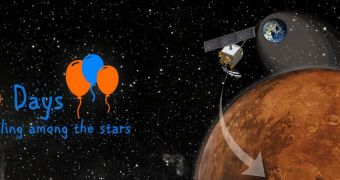Mission controllers with the Indian Space Research Organization (ISRO) are proud to announce that their first mission to the Red Planet, dubbed that Mars Orbiter Mission (MOM) has recently exceeded its 100-day mark in space. The threshold was reached on February 12, 2014.
MOM is the first mission ever developed by ISRO for exploring another planet. The orbiter was launched into space on November 5, 2013, aboard a PSLV-XL heavy-lift delivery system. The mission took off from the First Launch Pad at the Satish Dhawan Space Centre in the Andhra Pradesh province.
The PSLV (Polar Satellite Launch Vehicle) rocket was successful in parking MOM in a temporary Earth orbit for a couple of weeks, before the vehicle departed for the Red Planet. The 1,350-kilogram (2,980-pound) spacecraft is currently scheduled to reach Mars on September 24, 2014.
The main goal of the MOM mission is to study the Martian atmosphere and search for any potential signs of methane. This chemical has been identified by previous orbiter at Mars; however, researchers are still unsure as to what is producing it.
According to scientists, the Red Planet features a lot more methane than it should, which suggests that there are at least some sources that replenish it. These sources can be either natural or biological, and it is the latter possibility that interests planetary scientists the most, Universe Today reports.
MOM has thus far traveled around 16 million kilometers (10 million miles), so it takes roughly 55 seconds for radio signals to reach it. The spacecraft took $69 million (€50 million) to put together, and features know-how from the American space agency.
A recent status check performed by ISRO some two weeks ago has revealed that the science payload aboard MOM has been successfully turned on, and was operating within parameters. There are currently five Indian-built instruments on the spacecraft, weighing some 15 kilograms (33 pounds).
The MOM vehicle is currently flying on a heliocentric elliptical trajectory to the Red Planet, on which it was inserted following a series of six engine firings, the last of which occurred on December 1, 2013.

 14 DAY TRIAL //
14 DAY TRIAL //